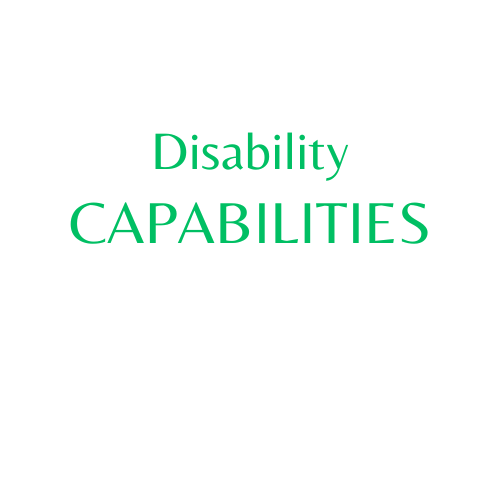The Capability Approach to Disability & Neurodivergence

Disability is conceptualized in many contexts and frameworks.
One of the most inspiring and empowering approaches of handling disability in a society is the Capability Approach (CA). This asserts that disability must be handled constructively by critiquing the barriers people with disabilities face in achieving their goals with the competencies and abilities they possess[1].
The Capability Approach (CA) directly challenges discapability, which we defined in a previous post as putting a person with a disability or neurodivergent tendency in a glass box where their capabilities are limited in terms of their objectives and ambitions because of the structures and systems of the society they live in.
CA views a disabled or neurodivergent person as an individual with many abilities that can be set apart and enhanced to enable such a person to meet their goals despite any impairments they might be living with.
Thus, the Capability Approach proceeds with the view that disability and neurodivergence should not become an impediment to the attainment of optimal functionality and optimal capability in persons living with these conditions.
The Capability Approach therefore goes with the following fundamental ideas:
1. Disability and neurodivergence in people are part of their human condition,
2. Disability and neurodivergence should not be problematized, rather, they should be seen in the same way as sickness, pregnancy, or aging,
3. Society should make provisions to include, engage, and optimize the participation of neurodivergent and disabled persons,
4. There should be targeted public policies that address public stigma, prejudice, and a continuous enhancement of the place of neurodivergent and disabled persons, and
5. The formulation of policies for the identification and enhancement of capabilities in people with disabilities.
Scholars like Martha Nussbaum assert that the Capability Approach must lead to a normative framework where disabled persons must be given certain basic rights within the theory of justice to ensure they flourish in society[2]. This involves a quest for the recognition and enhancement of an individual’s dignity through the convergence of competencies in neurodiverse and disabled persons, and allowing them to generate value for others.
Basically, work gives each and every one of us dignity. The ability to serve others, and achieve satisfaction by serving other human beings gives us a purpose and essence in life. The dignity of work goes beyond the intrinsic value of serving others – it encompasses the obvious generation of income through dignified effort[3].
Therefore, the Capabilities Approach argues that a modern society where the civil rights of all citizens are recognized must have practical mechanisms to harness and engage people irrespective of their disabilities or neurological tendencies and trends.
Thinkers from the Global South like Amartya Sen take a social approach. They identify that there is a positive relationship between social barriers and individual limitations, therefore, the Capabilities Approach must actively enhance the autonomy of disadvantaged persons through freedom, competency development, and elimination of dissatisfaction with income among disabled and disadvantaged persons[4].
In practical terms, what is most important is to set priorities and deploy resources within a state or community in ways that empower, enhance participation, and optimize the inputs of disabled and neurodivergent persons[5]. This must be targeted and driven by empirical analysis aimed at improving functionality among disabled and neurodivergent persons[6].
Scholars and practitioners have debated extensively about how best to attain this end[7][8][9]. However, what is objectively recognized is that the Capability Approach (CA) seeks to proactively accept disability and neurodivergence as a natural part of each person. This leads to the creation of practical mechanisms to ensure these disabilities do not become tools for discapability which leads to the underutilization of competencies because of disability or neurodivergence. Ultimately, society needs to develop the most efficient and effective ways of attaining the three cardinal pointers of the Capability Approach: (1) empowerment, (2) enhanced participation, and (3) optimization of competencies and inputs of persons with disabilities and/or neurodivergence.
[1] Christopher Riddle. Disability and Justice: The Capabilities Approach in Practice. (Lanham, MD: Lexington Books, 2014) pp15, 28, 35
[2] Nussbaum, Martha. Creating Capabilities: The Human Development Approach. Cambridge, MA: Harvard University Press, 2011) p19
[3] Ibid pp21-22
[4] Tania Burchardt. "Capabilities and disability: the capabilities framework and the social model of disability" Disability & Society 19 (7) 2004 pp735-751
[5] Caroline Harnacke. "Disability and capability: exploring the usefulness of Martha Nussbaum's capabilities approach for the UN disability rights convention" Journal of Law & Medical Ethics 41 (4) 2013 pp768-780
[6] Sophie Mitra. “The Capability Approach and Disability” Journal of Disability Policy Studies 16 (4) 2006 pp236-247
[7] Jean-Francois Trani, Parul Bakshi, Nicolo Bellanca, Mario Biggeri & Francesca Marchetta. "Disabilities through the Capability Approach lens: Implications for public policies" Alter 5 (3) 2011 pp143-157
[8] Jessica Begon. "4 Capabilities for Control" Disability Through the Lens of Justice (Oxford, 2023; online edn, Oxford Academic, 18 May 2023)
[9] Lorella Terzi. "27 - Capability and Disability from Part III - Issues in Public Policy" The Cambridge Handbook of the Capability Approach 2020 (Cambridge: Cambridge University Press, 2020) pp544-561





